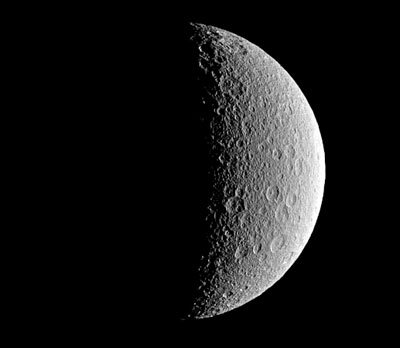|
|
|
November 29, 2010 from DiscoverMagazine Website
Saturn's moon Rhea,
as seen by the Cassini spacecraft in 2009.
When the news comes from Saturn's moons, the source is typically Titan - with its hazy atmosphere and frigid surface lakes of methane - or Enceladus - with its plumes of water ice.
Last week, however, word came that Rhea, the second-largest Saturnian satellite, has some surprises of its own.
In Friday's edition of Science, a study by Ben Teolis and colleagues confirmed that during a pass of the moon in March, when the ever-reliable Cassini spacecraft cruised over Rhea's pole at an altitude of just 60 miles, it directly sampled tiny amounts of oxygen and carbon dioxide there.
"This really is the first time that we've seen oxygen directly in the atmosphere of another world," said Andrew Coates, at UCL's Mullard Space Science Laboratory, a co-author of the study.
Other atmospheres known to exist throughout the solar system, like that of Titan as well as Jupiter's moons Europa and Ganymede, were discovered and studied from afar. Rhea's, however, is so thin that this direct pass through it was the only way to be sure it was there.
The astronomers believe the same process that creates the atmospheres of Europa and Ganymede is also at work on Rhea: Charged particles strike the ice on the surface, breaking it apart and freeing molecules to feed the moon's thin envelope.
Cassini's data show that molecular oxygen (O2) forms inside the moon's surface ice when water molecules (H2O) are split by energetic ions, a process known as radiolysis. The oxygen then gets ejected from the surface ice and captured by Rhea's gravity to form the atmosphere.
So while Rhea's ethereal haze isn't what you'd look for in a life-supporting environment, its existence points to the possibility of more atmospheric creation in the solar system - and across the Milky Way.
"All this suggests these kinds of exospheres may be very common," said Dr Teolis.
"There are different moons at Saturn and at Uranus, for example, which should be massive enough to hold an atmosphere. And, presumably, this kind of thing is duplicated billions of times throughout the galaxy. This could be something happening all over the place." [BBC News]
|


